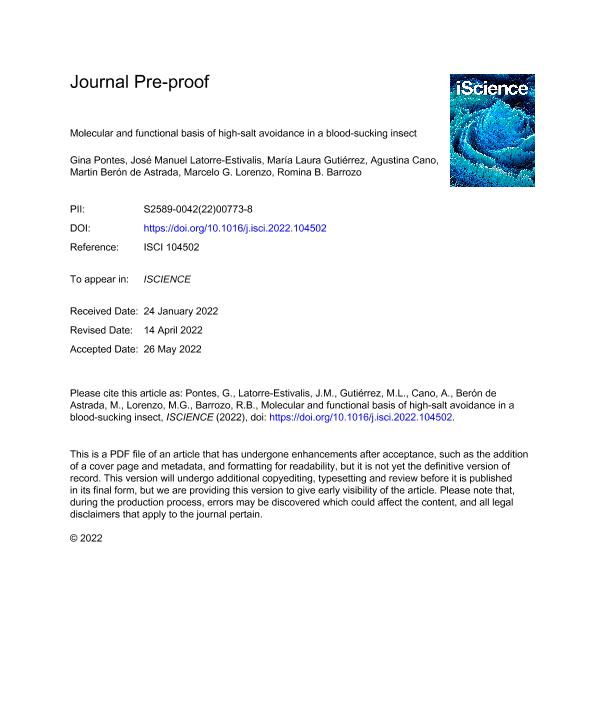Artículo
Molecular and functional basis of high-salt avoidance in a blood-sucking insect
Barcelos Pontes, Gina ; Latorre Estivalis, Jose Manuel
; Latorre Estivalis, Jose Manuel ; Gutiérrez, María Laura
; Gutiérrez, María Laura ; Cano, Agustina
; Cano, Agustina ; Berón de Astrada, Martín
; Berón de Astrada, Martín ; Lorenzo, Marcelo Gustavo
; Lorenzo, Marcelo Gustavo ; Barrozo, Romina
; Barrozo, Romina
 ; Latorre Estivalis, Jose Manuel
; Latorre Estivalis, Jose Manuel ; Gutiérrez, María Laura
; Gutiérrez, María Laura ; Cano, Agustina
; Cano, Agustina ; Berón de Astrada, Martín
; Berón de Astrada, Martín ; Lorenzo, Marcelo Gustavo
; Lorenzo, Marcelo Gustavo ; Barrozo, Romina
; Barrozo, Romina
Fecha de publicación:
06/2022
Editorial:
Elsevier
Revista:
iScience
ISSN:
2589-0042
Idioma:
Inglés
Tipo de recurso:
Artículo publicado
Clasificación temática:
Resumen
Salts are essential nutrients required for many physiological processes, and accordingly, their composition and concentration are tightly regulated. Taste is the ultimate sensory modality involved in resource quality assessment, resulting in acceptance or rejection. Here we found that high salt concentrations elicit feeding avoidance in the blood-sucking bug Rhodnius prolixus and elucidate the molecular and neurophysiological mechanisms involved. We found that high-salt avoidance is mediated by a salt-sensitive antennal gustatory receptor neuron (GRN). Using RNAi, we demonstrate that this process requires two amiloride-sensitive pickpocket channels (PPKs; RproPPK014276 and RproPPK28) expressed within these cells. We found that antennal GRNs project to the insect primary olfactory center, the antennal lobes, revealing these centers as potential sites for the integration of taste and olfactory host-derived cues. Moreover, the identification of the gustatory basis of high-salt detection in a hematophagous insect suggests novel targets for the prevention of biting and feeding.
Palabras clave:
BIOLOGICAL SCIENCES
,
NEUROSCIENCE
,
SENSORY NEUROSCIENCE
Archivos asociados
Licencia
Identificadores
Colecciones
Articulos(IBBEA)
Articulos de INSTITUTO DE BIODIVERSIDAD Y BIOLOGIA EXPERIMENTAL Y APLICADA
Articulos de INSTITUTO DE BIODIVERSIDAD Y BIOLOGIA EXPERIMENTAL Y APLICADA
Articulos(IFIBYNE)
Articulos de INST.DE FISIOL., BIOL.MOLECULAR Y NEUROCIENCIAS
Articulos de INST.DE FISIOL., BIOL.MOLECULAR Y NEUROCIENCIAS
Articulos(OCA CIUDAD UNIVERSITARIA)
Articulos de OFICINA DE COORDINACION ADMINISTRATIVA CIUDAD UNIVERSITARIA
Articulos de OFICINA DE COORDINACION ADMINISTRATIVA CIUDAD UNIVERSITARIA
Articulos(OCA HOUSSAY)
Articulos de OFICINA DE COORDINACION ADMINISTRATIVA HOUSSAY
Articulos de OFICINA DE COORDINACION ADMINISTRATIVA HOUSSAY
Citación
Barcelos Pontes, Gina; Latorre Estivalis, Jose Manuel; Gutiérrez, María Laura; Cano, Agustina; Berón de Astrada, Martín; et al.; Molecular and functional basis of high-salt avoidance in a blood-sucking insect; Elsevier; iScience; 25; 7; 6-2022; 1-27
Compartir
Altmétricas



